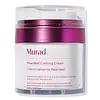What's inside
What's inside
 Key Ingredients
Key Ingredients

No key ingredients
 Benefits
Benefits

 Concerns
Concerns

 Ingredients Side-by-side
Ingredients Side-by-side

Water
Skin ConditioningCaprylic/Capric Triglyceride
MaskingGlycerin
HumectantGlyceryl Behenate
EmollientVitis Vinifera Seed Oil
EmollientBehenyl Alcohol
EmollientLecithin
EmollientHouttuynia Cordata Extract
Skin ConditioningCeramide NP
Skin ConditioningPhaeodactylum Tricornutum Extract
HumectantUrea
BufferingYeast Amino Acids
HumectantTrehalose
HumectantInositol
HumectantTaurine
BufferingBetaine
HumectantLactobacillus Ferment
Skin ConditioningHelianthus Annuus Seed Oil
EmollientHydroxyacetophenone
AntioxidantTocopherol
AntioxidantEthylhexylglycerin
Skin ConditioningPropanediol
SolventSodium Acrylates Copolymer
Xanthan Gum
EmulsifyingCitric Acid
BufferingLeuconostoc/Radish Root Ferment Filtrate
AntimicrobialChlorphenesin
AntimicrobialDehydroacetic Acid
PreservativeSodium Benzoate
MaskingWater, Caprylic/Capric Triglyceride, Glycerin, Glyceryl Behenate, Vitis Vinifera Seed Oil, Behenyl Alcohol, Lecithin, Houttuynia Cordata Extract, Ceramide NP, Phaeodactylum Tricornutum Extract, Urea, Yeast Amino Acids, Trehalose, Inositol, Taurine, Betaine, Lactobacillus Ferment, Helianthus Annuus Seed Oil, Hydroxyacetophenone, Tocopherol, Ethylhexylglycerin, Propanediol, Sodium Acrylates Copolymer, Xanthan Gum, Citric Acid, Leuconostoc/Radish Root Ferment Filtrate, Chlorphenesin, Dehydroacetic Acid, Sodium Benzoate
Water
Skin ConditioningPropanediol
SolventCaprylic/Capric Triglyceride
MaskingGlycerin
HumectantButylene Glycol Dicaprylate/Dicaprate
Emollient1,2-Hexanediol
Skin ConditioningHydrogenated Polydecene
EmollientHelianthus Annuus Seed Oil
EmollientPolyglyceryl-3 Methylglucose Distearate
EmulsifyingPanthenol
Skin ConditioningSimmondsia Chinensis Seed Oil
EmollientSpirulina Platensis Extract
Skin ProtectingRhodomyrtus Tomentosa Fruit Extract
HumectantArtemisia Vulgaris Extract
Skin ConditioningCentella Asiatica Extract
CleansingBrassica Oleracea Italica Extract
AstringentCurcuma Longa Root Extract
MaskingSodium Polyacryloyldimethyl Taurate
Emulsion StabilisingSorbitan Olivate
EmulsifyingArginine
MaskingMelia Azadirachta Leaf Extract
Skin ConditioningSpinacia Oleracea Leaf Extract
Skin ConditioningGlyceryl Stearate
EmollientSorbitan Sesquioleate
EmulsifyingButylene Glycol
HumectantDextrin
AbsorbentAllantoin
Skin ConditioningCarthamus Tinctorius Flower Extract
Skin ConditioningGardenia Florida Fruit Extract
Skin ConditioningMelia Azadirachta Flower Extract
Skin ConditioningCetearyl Olivate
Carbomer
Emulsion StabilisingCoccinia Indica Fruit Extract
Skin ConditioningSolanum Melongena Fruit Extract
Skin ConditioningAloe Barbadensis Flower Extract
EmollientOcimum Sanctum Leaf Extract
Skin ConditioningCorallina Officinalis Extract
Skin ConditioningCaprylyl Glycol
EmollientWater, Propanediol, Caprylic/Capric Triglyceride, Glycerin, Butylene Glycol Dicaprylate/Dicaprate, 1,2-Hexanediol, Hydrogenated Polydecene, Helianthus Annuus Seed Oil, Polyglyceryl-3 Methylglucose Distearate, Panthenol, Simmondsia Chinensis Seed Oil, Spirulina Platensis Extract, Rhodomyrtus Tomentosa Fruit Extract, Artemisia Vulgaris Extract, Centella Asiatica Extract, Brassica Oleracea Italica Extract, Curcuma Longa Root Extract, Sodium Polyacryloyldimethyl Taurate, Sorbitan Olivate, Arginine, Melia Azadirachta Leaf Extract, Spinacia Oleracea Leaf Extract, Glyceryl Stearate, Sorbitan Sesquioleate, Butylene Glycol, Dextrin, Allantoin, Carthamus Tinctorius Flower Extract, Gardenia Florida Fruit Extract, Melia Azadirachta Flower Extract, Cetearyl Olivate, Carbomer, Coccinia Indica Fruit Extract, Solanum Melongena Fruit Extract, Aloe Barbadensis Flower Extract, Ocimum Sanctum Leaf Extract, Corallina Officinalis Extract, Caprylyl Glycol
 Reviews
Reviews

Ingredients Explained
These ingredients are found in both products.
Ingredients higher up in an ingredient list are typically present in a larger amount.
This ingredient is an emollient, solvent, and texture enhancer. It is considered a skin-softener by helping the skin prevent moisture loss.
It helps thicken a product's formula and makes it easier to spread by dissolving clumping compounds.
Caprylic Triglyceride is made by combining glycerin with coconut oil, forming a clear liquid.
While there is an assumption Caprylic Triglyceride can clog pores due to it being derived from coconut oil, there is no research supporting this.
Learn more about Caprylic/Capric TriglycerideGlycerin is already naturally found in your skin. It helps moisturize and protect your skin.
A study from 2016 found glycerin to be more effective as a humectant than AHAs and hyaluronic acid.
As a humectant, it helps the skin stay hydrated by pulling moisture to your skin. The low molecular weight of glycerin allows it to pull moisture into the deeper layers of your skin.
Hydrated skin improves your skin barrier; Your skin barrier helps protect against irritants and bacteria.
Glycerin has also been found to have antimicrobial and antiviral properties. Due to these properties, glycerin is often used in wound and burn treatments.
In cosmetics, glycerin is usually derived from plants such as soybean or palm. However, it can also be sourced from animals, such as tallow or animal fat.
This ingredient is organic, colorless, odorless, and non-toxic.
Glycerin is the name for this ingredient in American English. British English uses Glycerol/Glycerine.
Learn more about GlycerinHelianthus Annuus Seed Oil is the oil derived from the seeds of a Sunflower. Sunflower seed oil is non-fragrant. It is an emollient, meaning it helps to soften the skin.
Sunflower seed oil contains many fatty acids. The fatty acids found in sunflower seeds include (from highest amount to least): linoleic acid, myristic acid, palmitic acid, stearic acid, arachidic acid, oleic acid, and linolenic acid.
These fatty acids help the skin create ceramides. Ceramides play a role in repairing the skin barrier.
Helianthus Annuus Seed Oil helps moisturize the skin. This in turn helps the skin look more rejuvenated and smoother.
Sunflowers are rich in vitamin E.
Historians believe Indigenous cultures of North America domesticated sunflowers before corn. Thus they relied on sunflower oil for a variety of uses. One such use is moisturizing skin and hair.
Sunflower seed oil may not be fungal acne safe. We recommend speaking with a professional if you have any concerns.
Learn more about Helianthus Annuus Seed OilPropanediol is an all-star ingredient. It softens, hydrates, and smooths the skin.
It’s often used to:
Propanediol is not likely to cause sensitivity and considered safe to use. It is derived from corn or petroleum with a clear color and no scent.
Learn more about PropanediolWater. It's the most common cosmetic ingredient of all. You'll usually see it at the top of ingredient lists, meaning that it makes up the largest part of the product.
So why is it so popular? Water most often acts as a solvent - this means that it helps dissolve other ingredients into the formulation.
You'll also recognize water as that liquid we all need to stay alive. If you see this, drink a glass of water. Stay hydrated!
Learn more about Water